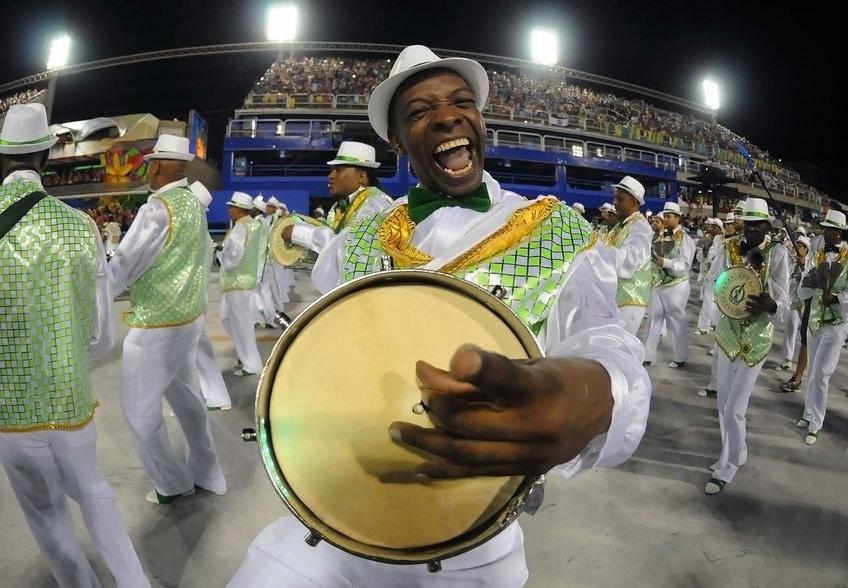Getting in the Groove: Why samba makes everyone want to dance
Year after year, carnival in Rio makes one thing perfectly clear: samba moves people. The pounding drums elicit exuberant movement and ecstatic displays of emotion. But what is it that makes this music so special? What is the secret of these mesmerizing drum groups? Scientists at the Max Planck Institute for Human Cognitive and Brain Sciences (MPI CBS) and the D'OR Institute for Research and Education in Rio de Janeiro now believe it has to do with synchrony. Greater synchrony between beats of the drums leads to stronger emotion and greater activation of brain areas responsible for rhythm, movement, and prediction in listeners.

The carnival parades in Rio de Janeiro are unique. Central to the parades are the percussion sections, featuring hundreds of drummers. The drums accompany the chants and procession of the 'samba school'. The percussionists not only bring the musicians and dancers to an ecstatic state, but also the audience. The vast crowds are swept away by the atmosphere, feeling connected, happy, and excitedly bouncing and gyrating with the beat. Even self-described 'carnival or dance mufflers' can't resist.
Annerose Engel, neuroscientist and neuropsychologist at the MPI CBS and the University Hospital Leipzig wanted to know what it is about samba that makes it so effective at inciting this "groove". What is it about the percussion that leads to such joy and the irresistible urge to move? Is it the synchronous interplay of the musicians or perhaps the sheer volume? And what about the brain? What happens in the brain when we're swept away by the beat?
To answer these questions Dr. Engel travelled to Rio and hired a renowned percussion section master of a samba school. They recorded and arranged a piece of music featuring the nine rhythm instruments of a typical samba percussion section. Engel then created four versions where the interplay between the instrument groups was manipulated, based on the accented steady pulse of the snare drums: the original version and versions with 28, 55, and 83 millisecond delay of the snare in relation to the other instruments.
Testing was done in Brazil with participants who liked samba. Most could also play samba rhythms on an instrument. The different versions were first heard by 12 individuals with variable volume; either loud (85 db) or very loud (95 db). Each person rated how strong the urge to move was and how pleasant they found the music. In a second experiment, another 21 participants listened to the music while their brain activity was measured with functional magnetic resonance imaging.

Not surprisingly, sections more precisely timed were perceived as more pleasant and animating. The louder the pieces were presented, the stronger was the urge to move. The maximal effect occurred when precisely timed instruments were played loudly. Interestingly, participants with better rhythmic abilities were more sensitive to the synchrony manipulation.
And what exactly does 'groove' look like in the brain? The more precisely timed instruments more vigorously activated a network of brain regions involved in the control of movement and rhythm perception. More specifically, the supplementary motor area, the left premotor cortex, and the left frontal gyrus. These regions underlie not only movement but are also active when something is to be predicted, a fundamental function of perception. "The activity in the network of these motor regions may form the neural basis for feeling the groove, especially the pronounced urge to move" explains Engel, first author of the study, now published in the journal Frontiers of Neuroscience. "We suggest that the more synchronously the instruments interact, the easier the underlying beat is perceived, which would presumably facilitate prediction processes." This ties in nicely with a further finding.

Synchrony between musicians is known to generate feelings of social connectedness and therefore it was hypothesized that similar feelings may arise in listeners. Indeed, a wide range of emotions were reported, with some study participants having very intensive experiences while listening to samba percussion in particular. These so-called “deep listeners” showed heightened activity in a brain area called the subgenual cingulate, specifically during the most precisely timed piece. This region has known roles in social bonding, affiliation, prosocial behavior, and group identification it has also been postulated to mediate positive emotion in exactly this type of situation. Presumably, the perception of synchrony also triggers entrainment processes in the brain, which in turn have an important role in emotional experience.
The researchers assume that their observations would also apply to other styles of music or even ritual dance music of other cultures. They may also generally help to explain why 'tighter' musical performances are experienced as better, with clearer and more definite beats possibly leading to stronger "groove" sensations.
"These findings could even help us in neurorehabilitation," says Engel. Music is already used for the treatment of stroke or other neurological diseases. Firstly, it helps motivate patients to move. But rhythm can also help them relearn movement sequences and improve attention and many other cognitive functions. "Music, like samba, that has an intense 'groove factor' could be particularly suitable for this", says the neuropsychologist. "It apparently activates a network of motor associated brain areas particularly strongly, which is often required for rehabilitation, and also relevant in predictive processes."
Listen to the study’s music pieces here.





